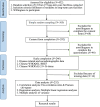Associations among quality of life, activities, and participation in elderly residents with joint contractures in long-term care facilities: a cross-sectional study
- PMID: 35279091
- PMCID: PMC8917858
- DOI: 10.1186/s12877-022-02870-6
Associations among quality of life, activities, and participation in elderly residents with joint contractures in long-term care facilities: a cross-sectional study
Abstract
Background: Joint contractures and degenerative osteoarthritis are the most common joint diseases in the elderly population, can lead to limited mobility in elderly individuals, can exacerbate symptoms such as pain, stiffness, and disability, and can interfere with social participation and quality of life, thus affecting mental health. However, relevant studies on this topic are very limited. This study describes the associations of joint contracture categories and sites in elderly residents in long-term care facilities with their quality of life, activities, and participation.
Methods: Elderly individuals with joint contractures who were residents in long-term care facilities were recruited. The World Health Organization (WHO) Quality of Life and the WHO Disability Assessment Schedule 2.0 were used to survey the participants. Correlations, multiple linear regressions, and multiple analyses of variance, with joint contractures as the response variable, were used in the statistical analysis.
Results: The final statistical analysis included 232 participants. The explanatory power of contracture sites on activities and participation had a moderate strength of association (η2 = .113). Compared with elderly residents with joint contractures and osteoarthritis isolated to the upper limbs, those with joint contractures and osteoarthritis in both the upper and lower limbs had significantly worse activity and participation limitations. No significant differences in activity and participation were found between elderly residents with joint contractures affecting only the upper limbs and those with joint contractures affecting only the lower limbs (F1,226 = 2.604 and F1,226 = 0.674, nonsignificant). Osteoarthritis had the greatest impact on activity limitations and participation restrictions among elderly residents with joint contractures affecting both the upper and lower limbs (F1,226 = 6.251, p = .014).
Conclusions: Elderly residents in long-term care facilities belonging to minority groups, with a history of stroke, and with osteoarthritis are at a high risk of developing activity limitations and participation restrictions. Moreover, compared with other contraction sites, regardless of osteoarthritis, joint contractures affecting both the upper and lower limbs were associated with the greatest activity limitations and participation restrictions.
Trial registration: This study has been registered in the Chinese Clinical Trial Registry, registration number and date: ChiCTR2000039889 (13/11/2020).
Keywords: Activity limitations; Elderly residents; Joint contractures; Osteoarthritis; Participation restrictions; Quality of life.
© 2022. The Author(s).
Conflict of interest statement
The authors declare that they have no competing interests.
Figures






References
-
- Harrington C, Carrillo H, Garfield R, Squires E. Nursing facilities, staffing, residents and facility deficiencies, 2009 through 2016. San Francisco (CA): Kaiser Family Foundation; 2018.
-
- Radstake TRDJ, McInnes IB, Bijlsma JWJ. World arthritis day 2018 - perspectives on rheumatic musculoskeletal diseases. Eur J Immunol. 2018;48:1604–1606.
-
- Xie F, Kovic B, Jin X, He X, Wang M, Silvestre C. Economic and humanistic burden of osteoarthritis: a systematic review of large sample studies. Pharmacoeconomics. 2016;34:1087–1100. - PubMed
Publication types
MeSH terms
LinkOut - more resources
Full Text Sources
Medical

